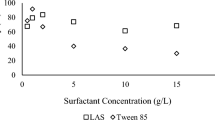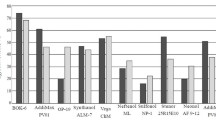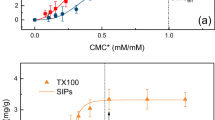Abstract
Sorption of three surfactants and personal care products in four types of commonly occurring Indian soils was extensively studied. The soils used in the study were red soil, clay soil, compost soil and sandy soil as classified by American Society for Testing and Materials (ASTM). The three surfactants used in the study were representative of cationic, non-ionic and anionic surfactant groups. The sorption of surfactants followed the descending order: sodium dodecyl sulphate (SDS) > trimethyl amine (TMA) > propylene glycol (PG). The maximum adsorption capacity (Qmax) was obtained in compost soil (28.6 mg/g for SDS; 9.4 mg/g for TMA and 4 mg/g for PG). The rate of adsorption was the maximum in compost soil followed by clay and red soils, and minimum for sandy soils. It is found that the Freundlich model fits the isotherm data better than the Langmuir model. Freundlich coefficient (K f) increased as the organic content of soils increased. Desorption of target pollutants in tap water was 20–50% whereas acid desorbs 40–90% of target pollutants from soil matrix. It was also found that the adsorption and desorption were significantly affected by the presence of clay and organic matter. The results also indicate that surfactants and personal care products, especially TMA and PG, are highly mobile in sandy soil followed by red soil. Therefore, immobilization of target pollutants is most economical and effective in compost and clayey soils whereas for other type of soils the combination of physiochemical and biological process will be effective option for remediation.







Similar content being viewed by others
References
Adak A, Pal A, Bandyopadhyay M (2005) Spectrophotometric determination of anionic surfactants in wastewater using acridine orange. Ind J Chem Technol 12(2):145–148
Aisien FA, Amenaghawon AN, Adinkwuye AI (2014) Batch study, equilibrium and kinetics of adsorption of naphthalene using waste tyre rubber granules. J Xenob 4(1):20–28
Al-Degs YS, El-Barghouthi MI, El-Sheikh AH, Walker GM (2008) Effect of solution pH, ionic strength, and temperature on adsorption behavior of reactive dyes on activated carbon. Dyes Pigments 77(1):16–23
Atay NZ, Yenigün O, Asutay M (2002) Sorption of anionic surfactants SDS, AOT and cationic surfactant Hyamine 1622 on natural soils. Water Air Soil Pollut 136(1–4):55–68
Azam MR, Tan IM, Ismail L, Mushtaq M, Nadeem M, Sagir M (2013) Static adsorption of anionic surfactant onto crushed Berea sandstone. J Petrol Explor Prod Technol 3(3):195–201
Blair BD, Crago JP, Hedman CJ, Klaper RD (2013) Pharmaceuticals and personal care products found in the Great Lakes above concentrations of environmental concern. Chemosphere 93(9):2116–2123
Bruno F, Curini R, Di Corcia A, Fochi I, Nazzari M, Samperi R (2002) Determination of surfactants and some of their metabolites in untreated and anaerobically digested sewage sludge by subcritical water extraction followed by liquid chromatography-mass spectrometry. Environ Sci Technol 36(19):4156–4161
Cao J, Guo H, Zhu HM, Jiang L, Yang H (2008) Effects of SOM, surfactant and pH on the sorption–desorption and mobility of prometryne in soils. Chemosphere 70(11):2127–2134
Chang CT, Chen BY, Shiu IS, Jeng FT (2004) Biofiltration of trimethylamine-containing waste gas by entrapped mixed microbial cells. Chemosphere 55(5):751–756
Das S, Mukherjee I, Paul BK, Ghosh S (2014) Physicochemical behaviors of cationic gemini surfactant (14-4-14) based micro-heterogeneous assemblies. Langmuir 30(42):12483–12493
Farzadkia M, RezaeiKalantary R, Mousavi G, Jorfi S, Gholami M (2010) The effect of organic loading on propylene glycol removal using fixed bed activated sludge hybrid reactor. Chem Biochem Eng Q 24(2):227–234
Fox K, Holt M, Daniel M, Buckland H, Guymer I (2000) Removal of linear alkylbenzenesulfonate from a small Yorkshire stream: contribution to GREAT-ER project# 7. Sci Total Environ 251:265–275
Fytianos K, Pegiadou S, Raikos N, Eleftheriadis I, Tsoukali H (1997) Determination of non-ionic surfactants (polyethoxylated-nonylphenols) by HPLC in waste waters. Chemosphere 35(7):1423–1429
Garcia-Delgado RA, Cotoruelo-Minguez LM, Rodriguez JJ (1992) Equilibrium study of single-solute adsorption of anionic surfactants with polymeric XAD resins. Sep Sci Technol 27(7):975–987
Holt MS, Fox KK, Burford M, Daniel M, Buckland H (1998) UK monitoring study on the removal of linear alkylbenzenesulphonate in trickling filter type sewage treatment plants. Contribution to GREAT-ER project# 2. Sci Total Environ 210:255–269
Kang S, Jeong HY (2015) Sorption of a nonionic surfactant Tween 80 by minerals and soils. J Hazard Mater 284:143–150
Krishna KR, Philip L (2008) Adsorption and desorption characteristics of lindane, carbofuran and methyl parathion on various Indian soils. J Hazard Mater 160(2):559–567
Kumar M, Philip L (2006) Adsorption and desorption characteristics of hydrophobic pesticide endosulfan in four Indian soils. Chemosphere 62(7):1064–1077
NCBI (National Center for Biotechnology Information) (2016) PubChem compound database; CID = 1030, https://pubchem.ncbi.nlm.nih.gov/compound/1030. Accessed 12 Feb 2016
Pavan PC, Crepaldi EL, Gomes GDA, Valim JB (1999) Adsorption of sodium dodecylsulfate on a hydrotalcite-like compound. Effect of temperature, pH and ionic strength. Colloids Surf A 154(3):399–410
Petrović M, Gonzalez S, Barceló D (2003) Analysis and removal of emerging contaminants in wastewater and drinking water. TrAC Trends Anal Chem 22(10):685–696
Purakayastha PD, Pal A, Bandyopadhyay M (2005) Sorption kinetics of anionic surfactant on to waste tire rubber granules. Sep Purif Technol 46(3):129–135
Qin Q, Chen X, Zhuang J (2015) The fate and impact of pharmaceuticals and personal care products in agricultural soils irrigated with reclaimed water. Crit Rev Environ Sci Technol 45(13):1379–1408
Ramprasad C, Philip L (2016) Surfactants and personal care products removal in pilot scale horizontal and vertical flow constructed wetlands while treating greywater. Chem Eng J 284:458–468
RavalPriti V, Desai Hemangi H (2012) Removal of anionic surfactant sodium dodecyl sulphate (SDS) from aqueous solution by using alumina. J Environ Res Dev 7(2A):851–862
Reznik GO, Vishwanath P, Pynn MA, Sitnik JM, Todd JJ, Wu J, Smith TF (2010) Use of sustainable chemistry to produce an acyl amino acid surfactant. Appl Microbiol Biotechnol 86(5):1387–1397
Rodriguez-Cruz MS, Sanchez-Martin MJ, Sanchez-Camazano M (2005) A comparative study of adsorption of an anionic and a non-ionic surfactant by soils based on physicochemical and mineralogical properties of soils. Chemosphere 61(1):56–64
Salager JL (2002) Surfactants types and uses. Fire p booket-E300-attaching aid in surfactant science and engineering in English. Merida Venezuela 2:1–49
Somasundaran P, Huang L (2000) Adsorption/aggregation of surfactants and their mixtures at solid–liquid interfaces. Adv Colloid Interface Sci 88(1):179–208
Ullah H, Khan I (2015) Effects of sewage water irrigation of cabbage to soil geochemical properties and products safety in peri-urban Peshawar, Pakistan. Environ Monit Assess 187(3):1–12
Acknowledgements
The authors acknowledge the support received from Ministry of Human Resources Development (MHRD), Government of India (GoI) for supporting this research activity.
Author information
Authors and Affiliations
Corresponding author
Additional information
Editorial responsibility: J. Aravind.
Electronic supplementary material
Below is the link to the electronic supplementary material.
Rights and permissions
About this article
Cite this article
Ramprasad, C., Philip, L. Sorption of surfactants and personal care products in Indian soils. Int. J. Environ. Sci. Technol. 14, 853–866 (2017). https://doi.org/10.1007/s13762-016-1188-8
Received:
Revised:
Accepted:
Published:
Issue Date:
DOI: https://doi.org/10.1007/s13762-016-1188-8




